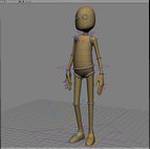Post
by Hellomojo » 16 Mar 2014, 11:12
Well this webinar tomorrow might influence our decision on Max/Maya/Other.
This is the text from the post mentioned above... re: the future of Maya and Bi-Frost etc.
============================================================================
have already shown the maya roadmap to about 60% of the softimage user base under NDA. I have had calls with several people on this forum last week and I apologize to those that I have not got to already. We will launch our new software line up this week and GDC is here with Nvidia GTC and NAB all back to back so things are crazy. Anyone that needs more information for their transition that has asked for a road map will get one in the next couple of months. There are users in a variety of different situations that have different things to weigh.
The largest community of softimage users is in Japan building games and most use the modeling and animation tools but very little ICE. This community is focusing on the transition to the PS4 and Xbox One console cycle and want features like DX11 APIs and .net programming as well as back end API for FBX and Middleware. The main work we did with Microsoft and Sony for supporting the next gen consoles was done in Maya although the transition for a games developer is pretty big when they have to swap out engines or back end pipelines. These users upgrade usually once every five years around the time a console changes. With the work you will see in Maya 2015 this week we are addressing most of the big modeling feature concerns in terms of legacy things like crappy Booleans and bevel and we have a whole new retopology tool set. We also have done tons of work on supporting UV tiling and workflows and ported over the Unfold 3D work into Maya.
As for the workflows we have an internal project called Project H (or Humanize Maya) where we are working with all sorts of users from students to pros to studios to come up with proposals to the problems that have come up here and in the Maya user base. We invite anyone here and many of you have taken up our offer to contribute and it is up to us to show that we are delivering over the next two years during the transition period. If we don't at the end than you will all have choices and plenty of time to evaluate your options.
As for ICE and Bifrost you will see this week the liquid workflows for generalists. We have three user personas we work with: generalists, tds, and programmers. If you want a great view of our thoughts on Bifrost than read this article from fx guide: https://www.fxguide.com/featured/bifrost-the-return-of-the-naiad-team-with-a-bridge-to-ice/ . The underlying procedural core that powers was written by a core group of developers that worked on ICE except this time they built it separate from Maya so that we could potentially re-use it in other areas. So we will show the benefits of a modern procedural core running on all CPUs but we will not expose the node graphing network underneath in the first version. As you will read in the article and see in the videos the graph which is very much like ICE is there but we want to focus on enabling a key workflow like liquids first for the big user base and then expose it to tds through a node graph interface and then programmers through an API. We have been working on this core for a long time so we are confident that it is ready for prime time with the hundred of thousands of Maya users out there today. Again those of you that want to take part in how we expose this procedural core through a node interface are welcome to join the beta.
As for modernizing Maya's core there are several components that make up the core of an application. This is by no means exhaustive but for this conversation let's imagine the primary components are UI, Viewport, Data model, and Evaluation. Higher level things like API and scripting are also in the equation. For Maya we ported the entire UI to QT over the last couple of years and you will see us start to take advantage of that in the 2015 release. The viewport 2.0 project will be completed in the 2015 release so we will make it the default viewport. This supports all the modern DX11 techniques like gpu tessellation, opensubdiv and will natively display UV tiling, Ptex, Alembic streaming, and most elements of the hypershade and good chunks of mental ray. With GPU caching and proper use of the GPU we are loading huge scenes into Maya and showing them with a much higher level of fidelity than ever before. With the new bifrost tiled architecture we are showing 200-300 m particles in some cases and they are interactive if you have a beefy enough gfx card.
For data we have been working with a lot of the larger studios on a project called open data. The alembic work we put into the open source came out of this project and we are actively working on projects like USD (http://graphics.pixar.com/usd/) and the future of how materials are stored openly (http://code.google.com/p/alembic/wiki/AbcMaterial) . The key is that the way data is stored is not owned by any one application but an open source framework so you can share data between applications, renderers, and frameworks. If you want to see how this comes together and benefits the user you can watch this video (http://www.youtube.com/watch?v=Qsn6i1YVZo8). This is also the future of how people will interact on the cloud as you will be have scenes that have objects with multiple representations including streamable assets. You can author in a lightweight environment and then pass around changes that are stored in open formats like json or xml and use whatever you want (Maya, Houdini, Fabric, C++) to bring it all together and back end tools like Shotgun can work with the data without having to load Maya. I don't think anyone on this list including Paul from Fabric that the future for storing data is in open standards that are supported by all tools and pipelines. The other key elements of the open data framework is working with remote data like drop box and autodesk 360. As more and more workflows go cloud having scenes that can reference remote elements and having compute on demand will be key for any facility that wants to keep costs in line with the production.
Evaluation is what you do with the data to get the resulting geometry, pixels, manipulators, etc... . Generalists make up a vast majority of the 3D user base. They like the 3dsmax, Maya, XSI model of being able to do modeling, animation, fx, and lighting in one package and the key constraint here is that you have to fit all of that into your memory. Each application has its own way of exposing that to user from a fully procedural environment like Houdini to mixed models like XSI, Maya, and Softimage to more direct always move forward models like Modo. We are currently evaluating how we can expose the history of Maya in a more operator like stack UI like Softimage but the underlying feature set is there. ICE is a mixed evaluation model with a modern procedural core plugged into a more interactive traditional model. I won't talk about the future on an open forum but the article written on fxguide shows a lot of the intent of what we are trying to do and we have been very clear that we want to capture the best elements of the ICE workflow with this new approach. For API/Scripting Maya is the industry standard for extensibility. We increased our python support and added .net (games industry standard) over the last few years. Maya is a great tool to plug into a pipeline. We are very confident that as we expose our backend procedural core to programmers people will have a choice between Fabric, Houdini Engine, and Maya and will probably mix them all together. The other work done on the API was to properly expose the rendering API to make Maya much more friendly to third party renderers. Now you can choose between Mental Ray, Vray, vue, Arnold, Renderman, Maxwell, Caustic, Iray, Furry Ball, Red Shift, Gorilla, and Otoy Octane. There are a few more hiding in the weeds that will come out this year that are great.
So for modernizing the application you have to start from the ground up and work your way towards the artist facing work. So in Maya 2015 as a games artist you will see exactly what you will see in the console or mobile device and load levels that match what can be seen on the xbox one or PS4. For a film/vfx artist you can work with high resolution subdivided meshes (open subdiv rocks) that have uv tiles painted in Mari and see a much closer view of the final look and you can choose between tons of great renderers that are not on Houdini or Modo or Soft.
Where we need to work on is user workflow and hiding the complexity of Maya. If you think of all the work that went into the work you see above the team is making this a top priority now that we have a modern base layer of UI, data, evaluation, and viewport on which to work. Maya sucks at lighting and rendering compared to Soft and we need to fix that along with a bunch of other things. If you want to hedge your bets than sign up for the roadmap or continue to write in here. Maya's modeling community have been working with us for two years to bring it up to speed with applications like modo and we have monthly drops and a tight community that keeps us honest. The videos in two days will be testament to that.
As for the whole NDA thing I am not going to apologize that is how we have to do business as that is how Adobe, Apple, and anyone else who is a public company has to operate. If you want to see what happens when you don't work that way look at what happened to Avid. (http://www.forbes.com/sites/bobbyowsinski/2014/02/27/major-changes-around-the-corner-for-music-as-avid-delists/) They played fast and loose with promises and they couldn't be honest with the people who invested in them. I am so tired of the whole public evil corporation thing as investors are people like you and me who just want to retire one day. Investment companies just keep these companies honest and the laws put in place prevent disasters like what happened with Enron where people were stealing money and getting away with it. We need to be responsible. There are no investors making calls at Autodesk. Everyone in this industry from the Foundry (google Caryle Group) to Fabric (Marc Petit big investor) have people that fund them and expect a return for their investment. Considering we have spoken with 60% of the user base already and plan on hitting 80% under NDA by Siggraph I think we are getting the best of both worlds. You as the user are informed about what we intend to do and we are not breaking any laws.
There are developers on soft right now and we will keep them there for two years. The list of things we can do to help the transition is in their hands and we will see what we can do. Just a reminder there is the softimage webinar tomorrow online.

































































